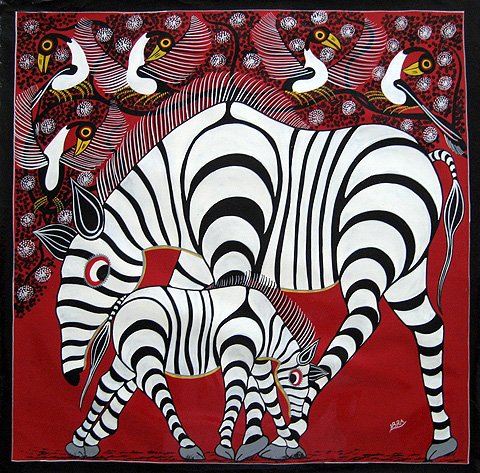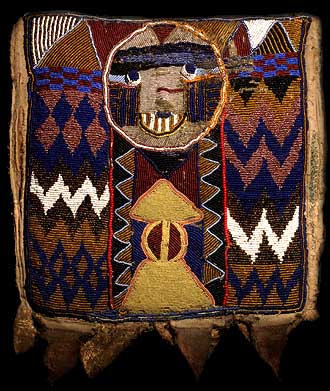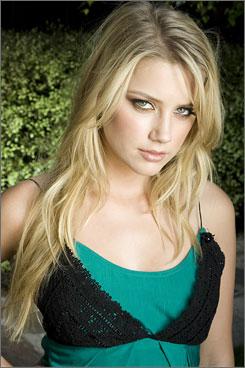With Austin starting his count down to Paris next week, thought OMG would help him out with some French for the trip.
So Austin listen up, here's some French that you can handle.
French Fries
French Connection
French Horn
French Doors
French Toast
French Resistance
French Open
French Dressing
French Maid
French Revolution
French Bulldogs
of course
French Kissing (but that's one that you might need some help with...it might have to wait until you find a Maple Leaf)
See how easy it is?
Then again you've been to France a time or two, and as a two too.
A Blog That Covers And Collects News Reports And Information On Artificial Intelligence, Robots, And Super Computers.
The Spirit of Alan Turing

The defining moment of the remarkable life of Alan Turing, one of Britain’s most original thinkers, came much earlier than many realise. It was not while Turing cracked Nazi codes at Bletchley Park to change the course of the Second World War. Nor when he lay the mathematical foundations of modern computing. Or that instant when, during a 1951 visit to the Science Museum, he was fired up by the lifelike behaviour of a cybernetic tortoise.
The Museum’s new Turing exhibition, which marks the centenary of his birth in 1912, shows that the signature moment of Turing’s life came on February 13, 1930, with the death of his classmate, Christopher Morcom, from tuberculosis. This shattering event propelled the great Turing through a remarkable career.
Morcom was Turing’s first love, a fellow, older pupil at Sherborne School, Dorset, who shared Turing’s passion for mathematics. Though Turing’s crush was not reciprocated, he was profoundly affected by the death of his friend. In a contribution towards an anthology for Morcom’s grieving mother, which is on display in the exhibition, Turing admitted that he ‘worshipped the ground he trod on’.
Morcom’s death cast a long shadow. Turing turned away from his Christian faith towards materialism, and began a lifelong quest to understand the tragedy. As he struggled to make sense of his loss, Turing pondered the nature of the human mind and whether Christopher’s was part of his dead body or somehow lived on.
Alan Turing is often portrayed as an isolated genius, even a borderline Asperger’s loner. This traditional depiction is, perhaps, a weak reflection of homophobia of recent decades. But read about his feelings for Morcom, his letters and the correspondence of those close to him and you obtain a more complete portrait. Far from being the insular genius of popular belief, Turing could be warm and gregarious, though he did not suffer fools gladly and had an original take on the way he lived his life as much as he conducted his science.
The October after the loss of his friend, Turing went up to Cambridge, where he studied mathematics. Our exhibition includes an essay, entitled “Nature of Spirit” that Turing wrote the next year, in 1932, in which he talked of his belief in the survival of the spirit after death, which appealed to the relatively recent field of quantum mechanics and reflected his yearning for his dear friend.
Around that time he encountered the Mathematical Foundations of Quantum Mechanics by the American computer pioneer, John von Neumann, and the work of Bertrand Russell on mathematical logic. These streams of thought would fuse when Turing imagined a machine that would be capable of any form of computation. Today the result – known as a universal Turing machine – still dominates our conception of computing.
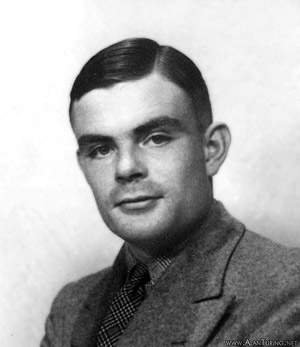
There Turing would break the codes of society too. In 1941, Turing had proposed marriage to Joan Clarke, a fellow cryptanalyst, but decided he could not go through with the marriage after admitting his homosexuality to his fiancée, who was reportedly “unfazed” by the revelation.
Turing’s greatest challenge at Bletchley was the German enciphering machine, Enigma, three of which are on show in our exhibition (including one kindly lent by Sir Mick Jagger). He took particular responsibility for reading U-boat communications and led a team that designed the great ‘bombe’, a calculating machine that successfully decoded Germany’s wartime messages. Eventually, over 200 were built, each weighing a ton, that made the noise of a ‘thousand knitting needles’ when in full flight.
The breaking of the Enigma was vital, partly because it meant that the Allies could intercept messages to the U-boats that were attacking convoys, sinking merchant ships and threatening to isolate Britain. It’s even been claimed that, without Bletchley Park’s contribution, the war might otherwise have been lost.
At that time a ‘computer’ was not a machine but a person, often female, who did calculations by hand. Machines were used too, but only for defined jobs, such as aiming bombs or solving differential equations. Combining his ideas from mathematical logic, his experience in cryptology, and the remarkable code cracking machinery of Bletchley, Turing’s ambition was to create a computer in the modern, electronic, flexible sense.
He joined the National Physical Laboratory, NPL, in Teddington in 1945 where his detailed – and world-beating – plan for an electronic computer was accepted in March 1946. But by then his remarkable wartime achievements were a state secret and he was not taken as seriously as he deserved. Frustrated, Turing resigned in 1948 though eventually, in 1950, his ideas came to life at NPL in the form of the Pilot ACE computer, which is the star of the Museum’s Turing exhibition.

On Midsummer Day 1948, the first prototype general-purpose computer, a true universal Turing machine, went into action at Manchester. And it was at Manchester University, when Turing was Deputy Director of the computing laboratory, that he wrote his highly influential 1950 paper, “Computing Machinery and Intelligence.”
Turing had pondered how intelligence could arise in a machine, from operations which were themselves routine and, in a way, mindless. Perhaps it was possible to construct an artificial consciousness from blocks of cold mathematical logic.
He had a practical suggestion: if a computer could fool people into thinking that they were interacting with another person, rather than a machine, then it could be classified as possessing artificial intelligence. This simple idea has proved hugely influential. Since 1991, an annual competition based on the ‘Turing test’ has been held by the American inventor Hugh Loebner.
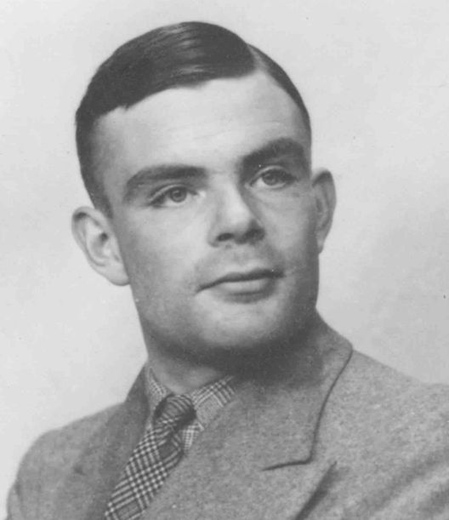
The next year Turing became interested in breaking the codes of life, furnishing a chemical basis for the means by which shape, structure and function arise in living things. It is known in biology as morphogenesis and had seemed so mysterious to some that it had fostered belief in vitalism, the idea that there was an élan vital that was distinct from physical or chemical forces.
Turing posed a basic question. How does an organism marshal a chemical soup into a biological structure or turn a spherical (symmetrical) bundle of identical cells into an (asymmetrical) organism? And why are there Fibonacci numbers (where each number is the sum of the previous two) in the leaf patterns of plants such as the close-packed spirals of sunflower heads? (our sister museum, the Museum of Science and Industry in Manchester, has carried out a mass experiment to investigate). Turing’s ideas have since led to some impressive descriptions of pattern formation in Nature, from snail shells to snake skins.
With the help of Age UK, the Science Museum has consulted lesbian and gay people who were alive in the 1950s to understand the moral climate. What became clear was that Turing was remarkably open about his homosexuality, despite the repressive attitudes of the day. Perhaps his logic and his honesty made him feel that his orientation could never be seen as a crime. After the sheltered, liberal environments of Cambridge and Bletchley, he was in for a shock.
Homosexuality was a criminal offence at the time and in February 1952 Turing was arrested for having a sexual relationship with a man, then tried and convicted of “gross indecency”. To avoid prison, he accepted treatment with the female sex hormone oestrogen: ‘chemical castration’ intended to neutralise his libido. In 2009 Gordon Brown, the then Prime Minister, issued a public apology for his treatment.
In that era, homosexual people were considered a security risk, being open to blackmail. Turing’s security clearance was withdrawn, so that he could no longer work for GCHQ, the post-war successor to Bletchley Park. He died soon after.
The precise circumstances leading to his demise on 7 June 1954, at home in Wilmslow, Cheshire, can never be known. But Turing had himself spoken of suicide and this was the conclusion of the coroner, following an inquest.
Next to Turing’s body was an apple, partly eaten. Years before, as some biographers have pointed out, Turing had gone to see Snow White and the Seven Dwarfs, the pioneering Disney film, in Cambridge, and was particularly taken with the scene where the Wicked Witch dangled an apple into a boiling cauldron: “Dip the apple in the brew. Let the Sleeping Death seep through”. One said that Turing had decided “to invest his departure from a world that had treated him shabbily with some of the gothic, eerie, colourful brilliance of a Disney film.”
The pathologist’s post-mortem report, reproduced in our new exhibition, suggests that the reality was more prosaic. The autopsy revealed that Turing’s stomach contained four ounces of fluid that smelt of bitter almonds: a solution of a cyanide salt. His death was not accidental: there was enough poison to fill a wine glass. Turing, thought the pathologist, had taken bites from the apple to make his last drink more palatable.
More than two decades earlier, when Turing was 17, he had had a vivid premonition of Morcom’s death, at the very instant that his first love was taken ill. Turing felt that this was an omen, one that lay beyond what science was able to explain.
Throughout his life he pursued the question of mind and body, believing that Morcom’s spirit lived on. Perhaps his suicide was one last experiment. On that cold, wet Whit Monday, did Turing take his own life in the hope that they would be together once more?
Who was Alan Turing, subject of the latest Google doodle?


Alan Turing Photos
New Delhi: The doodle on the Google home page on Saturday features a Turin machine, a device used to simulate the logic of a computer algorithm and is helpful in explaining the functioning of a CPU.
The doodle is an interactive doodle that requires users to break a set of six codes and each successful code break adds colour to a letter of the greyed out Google logo on doodle.
Considered to be the father of computing, Alan Mathison Turing was a British mathematician who articulated the mathematical foundation and limits of computing, and was a key contributor to the Allied cryptanalysis of the German Enigma cipher during World War II.

Alan Turing Photos
Alan Turing was born on June 23, 1912 in London, England, his father was an Indian Civil Services officer during the British rule. Turing graduated with mathematics from King's College, University of Cambridge in 1934.
During the Second World War he joined the British Government's Code and Cypher School and for his efforts in helping break the cryptic messages used by the Germans during the war he was made an officer of the Order of the British Empire.
After the war, Turing joined the National Physical Laboratory (NPL) where he designed and developed an electronic computer. He later quit the NPL to head the Computing Machine Laboratory where he designed the Ferranti Mark I which was the first electronic digital computer to be commercially available.
Turing was also a pioneer in the field of artificial intelligence. In 1950 he proposed, what was later known as the Turing test, a criterion to test whether a machine can think.

Alan Turing Photos
However, five years after the war Alan Turing was convicted of gross indecency under laws which banned homosexuality and was sentenced to chemical castration involving a series of injections of female hormones.
The conviction meant Alan Turing, a pioneer of modern computing, losing his security clearance and being unable to continue his work. In 1954 he killed himself at the age of 41.
Alan Turing's work with computers was not widely known beyond academic circles as Britain kept their role in the war secret.
Then Prime Minister Winston Churchill ordered that the Colossus computers and 200 so-called Bombe machines, used to crack the Enigma code, be destroyed to keep them secret from the Soviet Union. Bletchley's existence only came to light in the 1970s when the veil of secrecy was lifted.
Potter tribute to murdered actor
Cast and crew from the new Harry Potter film are to wear white ribbons on their wrists at its world premiere as a mark of respect to murdered actor Rob Knox. He was defending his brother when he was attacked by Karl Bishop, who received four life terms in March. The film's world premiere is being held in Leicester Square on Tuesday. Daniel Radcliffe, who plays the teenage wizard in the film, said Knox's death had hit all of the cast. He said: "I won't pretend I knew him incredibly well, or was his best friend on set, but I knew him and liked him, and what happened to him was obviously tragic and awful."
"It's going to be quite a traumatic experience for his family, who've been very supportive of him," she said. She said the wearing of white ribbons on their wrists was not only for his life but for other families who had experienced knife crime. The film is the sixth film based on JK Rowling's best-selling books and has director David Yates, who took charge of the last movie, Harry Potter and the Order of the Phoenix, back at the helm. He said Knox's death was a "waste". "You are surrounded by young people all day long who bring a great commitment to what they do, and Rob was no different," he said. "He came in and wanted to do brilliant work, he put his heart and soul into it, and you just think 'what a terrible waste'." | ||
Robert Knox: Harry Potter's Marcus Belby Killed (Photos)

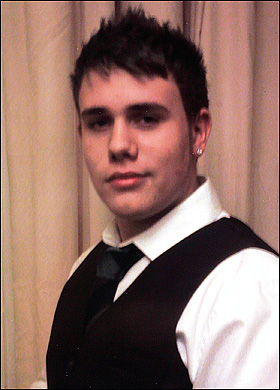
Chris Martin, 21, a friend of Robert and others in their group including Dean Saunders, 21, said: 'It kicked off last week outside the Metro. It was over a mobile phone.
'Some bloke said to Dean (Saunders), "You nicked my phone."
'Dean said he hadn't and this guy smacked him in the face and gave him a black eye.'
Mr Martin, who is a regular visitor to the Metro Bar, said he did not recognise Mr Saunders' attacker among the 'mostly local crowd'.
Mr Martin said the man had gone back to the bar last night armed with two knives and had threatened to hurt Mr Saunders.
Rob was caught up in the ensuing fracas, he added.A 21-year-old man has been arrested for Rob's death. However, Robert Knox's stabbing death is not an isolated incident. Rob is the 14th teenage victim to die this year in Britain from a knife or gunshot injury. Another victim, Jimmy Mizen, was part of the same rugby club as Knox and was killed in a bakery two weeks ago.
The Harry Potter character, Marcus Belby, is described in the books as "thin and nervous-looking" and part of Ravenclaw. His Uncle Damocles invented the Wolfsbane Potion, which prevents werewolves from changing during a full moon. The role was Robert Knox's first film appearance.
Murdered Harry Potter actor's mother 'out of tears'
The mother of the murdered teenager Robert Knox has "run out of tears" to express the pain of her loss, her husband has said.
 |
Brother Jamie and parents Colin and Sally Knox pay tribute to Robert Knox, the Harry Potter actor who was fatally stabbed in Sidcup Photo: PA |
He was stabbed to death outside a nightclub on Saturday as he tried to protect his younger brother from a man wielding two knives, after an apparent argument about mobile phones.
Mrs Knox said that he was "always the first person to stand up against wrong".
The younger brother he was protecting, Jamie, a 17-year-old Olympic hopeful in the martial art Tae Kwon Do, wrote a touching tribute.
He said: "I loved you so much. I know you would and will always be there for me. As much as you didn't know it I looked up to you so much. I would never have thought it would turn out this way. I thought you were invincible."

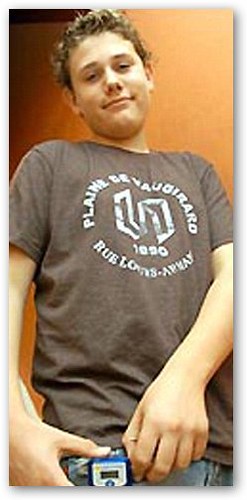


Mr Knox, who works in media production, said there was an explosion of emotion when he heard his son had died. But he said the couple had moved into denial and "Sally had run out of tears".
Earlier, he had been inconsolable as he visited the scene of the killing.
He laid a Mickey Mouse toy and flowers with a message that said: "You are my son, my buddy, and always will be. I love you so much. Sleep tight my baby. I have brought Mickey to keep you company. Love you so so much. Dad. xxx"
Robert's grandmother, Margaret, 79, called on every parent of teenagers "to take note of what they are carrying, search them, just try, at least try to put an end to this violence".
There was anger among Robert's the friends at the "sickening" waste of life.
Callum Turner, 18, told of how he cradled Robert in his arms as he died on the pavement.
"He looked into my eyes and said 'Callum, I need help, I need you to help me.' I knew he was in trouble. I knew he was slipping away, it was just so sad. There was nothing I could do to save him – he died in my arms.
"I will never forget that look in his eyes as his life ebbed away – it will haunt me forever."

 He added: "I just don't understand the person who did this to Rob – why did they have to carry a knife?
He added: "I just don't understand the person who did this to Rob – why did they have to carry a knife?
"Why attack someone who was defenceless and innocent? People running around with knives, they don't realise the value of life. It's sickening."
Four others were hurt in the fight outside Metro bar in Sidcup. They are being treated at separate London hospitals – a 21-year-old for a stab wound to the neck, a 16-year-old youth for a stab wound to the chest, and another man in his 20s for hand injuries.
Witnesses said that the attacker was well known for stealing mobile phones. He had been thrown out of the bar twice the week before, but returned in the early hours of Saturday morning wielding two knives and allegedly said: "Who's going to make my day then?"
He had allegedly threatened Jamie and when Robert heard about it, he confronted the attacker, and was stabbed four times. The man named locally as 21-year-old Karl Bishop, has been arrested in connection with the murder.
Robert was a member of the same rugby club as Jimmy Mizen, the 16-year-old murdered in a bakery in nearby Lee, south-east London, two weeks ago. His brother Danny Mizen, 30, said at the family home yesterday: "This boy is only from a few miles down the road so it's all very close and brings what happened to Jimmy crashing home again.
"It's just very hard for us right now. It's all so senseless. We feel for his family."
Earlier, he had been inconsolable as he visited the scene of the killing.
He laid a Mickey Mouse toy and flowers with a message that said: "You are my son, my buddy, and always will be. I love you so much. Sleep tight my baby. I have brought Mickey to keep you company. Love you so so much. Dad. xxx"
Robert's grandmother, Margaret, 79, called on every parent of teenagers "to take note of what they are carrying, search them, just try, at least try to put an end to this violence".
There was anger among Robert's the friends at the "sickening" waste of life.
Callum Turner, 18, told of how he cradled Robert in his arms as he died on the pavement.
"He looked into my eyes and said 'Callum, I need help, I need you to help me.' I knew he was in trouble. I knew he was slipping away, it was just so sad. There was nothing I could do to save him – he died in my arms.
"I will never forget that look in his eyes as his life ebbed away – it will haunt me forever."


"Why attack someone who was defenceless and innocent? People running around with knives, they don't realise the value of life. It's sickening."
Four others were hurt in the fight outside Metro bar in Sidcup. They are being treated at separate London hospitals – a 21-year-old for a stab wound to the neck, a 16-year-old youth for a stab wound to the chest, and another man in his 20s for hand injuries.
Witnesses said that the attacker was well known for stealing mobile phones. He had been thrown out of the bar twice the week before, but returned in the early hours of Saturday morning wielding two knives and allegedly said: "Who's going to make my day then?"
He had allegedly threatened Jamie and when Robert heard about it, he confronted the attacker, and was stabbed four times. The man named locally as 21-year-old Karl Bishop, has been arrested in connection with the murder.
Robert was a member of the same rugby club as Jimmy Mizen, the 16-year-old murdered in a bakery in nearby Lee, south-east London, two weeks ago. His brother Danny Mizen, 30, said at the family home yesterday: "This boy is only from a few miles down the road so it's all very close and brings what happened to Jimmy crashing home again.
"It's just very hard for us right now. It's all so senseless. We feel for his family."
Subscribe to:
Posts (Atom)











